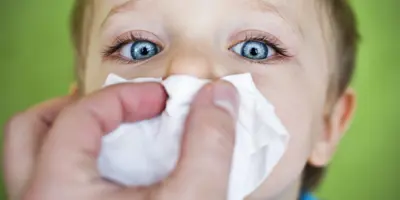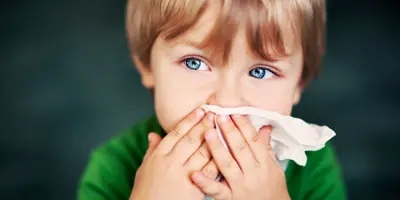6 people found this helpful

Having a cold can be tough on families, especially those with younger children who may not know should you blow your nose when you have a cold. It can be uncomfortable for kids suffering from a runny nose, and frustrating for parents trying to teach their child a new skill whilst keeping the germs from spreading. Here our top 5 tips on how to teach a child to blow their nose:
- Teach nose blowing when they’re well, so they’re ready when they’re snotty.
- Blow your nose as an example.
- Teach nose blowing with silly games.
- Teach kids not to do excessive nose blowing.
- Talk through nose-blowing with step-by-step instructions.
Should I blow my nose when I have a cold? Is it better to blow your nose or sniffle when you’re well? These questions and more will be answered. If you require medical advice or assurance, it is always best to consult with your GP. Children may sometimes wonder ‘is it good to blow your nose’ and our guide can help your kids master nose blowing by teaching them when they are well and leading by example. Keep those colds contained with our simple kid-friendly step-by-step guide on how to blow your nose:
1. Teach nose blowing when they're well
If you're teaching kids to blow their noses, make sure you tackle this handy skill before they actually get a cold. Congestion can interfere with their breathing1 and it can be overwhelming for them to try breathing through their nose while keeping their mouths shut. Teach them some tips when they are well, as they will be more enthusiastic about learning something new, and they can learn is it better to blow your nose or sniffle at times when they are well.
Keep a box of tissues in favourite play spots around the house so a tissue is always on hand for that runny nose. A tissue box with a fun colourful design, such as Cushelle, will make them extra tempting!
2. Blow your nose as an example
Take your time when teaching kids to blow their noses. They won't grasp the concept immediately, as it may take a little while before they understand that air comes out of their mouths and their noses.
Start by showing them what you do when you blow your nose, and explain to them why you do it. If they see you, your partner and their older siblings using tissues, they are more likely to copy. Provide them with a pack of super-soft facial tissues, like Cushelle, so they always have them at hand.
3. Teach nose blowing with silly games
As soon as they start to interact with toys, kids learn through play. And they learn through playing games as soon as they start to interact with others. You can harness this natural development to help with teaching kids to blow their noses.
The more fun and engaging you can make any process, the more likely little ones are to take it on board. And that goes double for the seemingly mundane activities we all have to do, like needing to blow your nose.
From imitation to bath games, you can teach how to teach a child to blow their nose by way of a few fun games:
- The imitation game. Sit opposite your little one, or in a circle if there are a few of you, and take turns blowing your nose – or at least pretending to. Be really patient and don’t be afraid to lavish them with cuddles and praise when they get it ‘right’ to reinforce the correct technique. And make it a fun and enjoyable game for them.
- Bubble bath. While keeping a close eye, encourage your children to blow bubbles in the bath, or ripples across the water, by blowing air out of their noses. The best way to play this game is to start blowing bubbles using air out of their mouth. Then you can teach them how to do the same thing with air from the nose. If you try to get them to do it with just the nose first, you run the risk of them not understanding what they’re supposed to do and/or getting frustrated.
- Foggy mirror. See who can fog up the mirror the most by blowing air through their nose. Show them how to pinch one nostril shut first to make it easier. This is a great natural progression from the bubble game, teaching kids how to control the airflow from their noses, which is a crucial step in learning the correct way to blow your nose.
- Feather races. Get the whole family together for a feather race. Blow feathers across the table by puffing air through your mouths, and then race again, this time just blowing air through noses, to see who can win.
- Practice, practice, practice. As with anything, the more we do it, the more automatic the process becomes. Whilst you don’t want to be dedicating hours at a time to nose-blowing education, little practice at regular intervals will make a huge difference very quickly. Most of the time they won’t even know they’re practising, like bubble blowing in the bath, and when you make it fun, they’ll happily play along anyway.
The two biggest keys to teaching kids to blow their noses are to be patient and to keep it light-hearted. They will get it in time and there’s no rush, so stick at it.
4. Teaching kids to avoid excessive nose blowing
Is it possible to blow your nose too hard? Sometimes, if your nose is really blocked, blowing alone won’t clear it – and it’s not a good idea to force it. Although serious consequences are very rare, there can be negative results of excessive nose blowing, including:
- Damage to blood vessels, which can cause nosebleeds.2
- Discomfort and irritation to the inside of the nose.
- Infection caused by the spread of bacteria to sinus cavities.3
Illnesses that result in runny noses and extra mucus also cause the nose lining itself to swell up, and both contribute to nasal congestion. This means that kids (and adults!) might feel the urge to over-blow their noses even if they are not clogged with mucus.1
As tempting as it can be to keep blowing forcefully, when teaching kids to blow their noses it’s important to remind them to be gentle. If they feel pressure after blowing, they may have blown too hard.1 Instead, you can try some simple home remedies to ease congestion naturally.
5. Talk through nose blowing with step-by-step instructions
When teaching your kids, it’s always a good idea to break the process down in easy steps. So, here’s a crash course for kids on how to blow your nose:
- Hold the tissue over your nose.
- Press a finger against one nostril.
- Blow gently out of the other nostril.
- Repeat the process with the other nostril.
- Remind them to bin the tissue each time and wash or sanitise their hands afterward.
It can take some time to master, so be patient with their efforts, and help them to practice before they end up with a stuffy nose. Armed with some soft Cushelle tissues, they will then be confident enough to try out their new skill and keep that runny nose and cold under control.
Teaching a kid when is it good to blow your nose can require a lot of patience, but it’s important to know as they grow older, especially for those that suffer from hay fever. These can develop into flus, so now your kid knows should you blow your nose when you have a cold? The answer is yes.
Sources:
1 ‘Health Check: What’s the right way to blow your nose?’,
2 ‘Nosebleed (Epistaxis)’, North Tees and Hartlepool NHS Trust
Related articles
4 tips for unblocking a newborn’s nose
Learn how to blow a baby's nose and how to teach nose blowing to older children with this guide on how to clean baby nose blockages.

How to stop a runny nose: why do we get runny noses and 5 ways to stop them for good
Find out how to stop a runny nose naturally. Discover our top tips, and natural and herbal remedies for a runny nose to stem the flow more quickly, here.

7 super simple home remedies for blocked noses
Is a blocked nose bothering you? Well, you’ve come to the right place. Check out these great blocked nose remedies to help you breathe easy!

Nosebleeds Causes: Why They Happen and How to Prevent Them
Learn about the most common nosebleeds causes here with Cushelle. Find out the link between a cold and a nosebleed, plus ways of preventing them.

5 Ways to Deal With Dust Allergies
If you think you have a house dust allergy, this article contains five dust allergy remedies to help you manage your symptoms. Click to read more.

Stuffy nose at night: how to get rid of a blocked nose at night
Discover some of the best ways to deal with a blocked nose at night. Find our simple home remedies here plus tips on the best way to sleep with a blocked nose.



